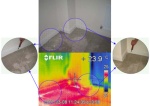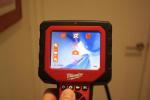
~ Invisible Invasive Inspections
Not sure if you have a leaky home? Think there’s a possibility you could have a problem?
So far, there are three common inspection practices.

- Thermal Imaging
- Moisture Testing
- Invasive Inspections
1. Thermal imaging is probably the most common on the market today and also usually the most expensive in the long run, the conditions in which the thermal imaging inspection is undertaken play a huge roll in their accuracy. Due to the seasonal changes and the moisture content or humidity in the air will dictate whether or not your thermal imaging report will be an accurate one, or miss the problem completely. A lot of leaky home owners find builders that are either not Licensed Building Practitioners or get their repairs carried out without notifying the council of the fact that their home is a leaky home. (for obvious reasons ie. selling)
This raises a new problem in leaky home repairs as a lot of jobs end up being patch up jobs, in which the builder has repaired the leaky home source, with out actually replacing the damaged parts of the framing in the building, conclusively turning the original wet rot into dry rot, and, as you have probably guessed, once the damaged timber turns to dry rot there is no way any thermal imaging camera will pick it up in their reports, no matter how expensive the camera may be.
2. Moisture testing is an effective way to identify the moisture content in your home and the possible percentage % of moisture your walls may be holding, but, it is limited in the fact that that is all moisture testing can provide (strictly an indication of moisture). This is a good and cheap test to run if you are trying to find out where you stand with your leaky home and how bad the extent of the damage may possibly be. But still leaving you with no definite answer as to whether or not you will require a reclad or an isolated repair.

See our Quick Moisture testing walk through video – Leaky home moisture testing!
3. Invisible Invasive Inspections are the most reliable source for you to utilize as a home owner when concerned about a leaky home. With an invasive inspection you actually get to see for yourself exactly what the condition of the timber in your damp wall is. In an invasive inspection, incisions are made with small holes in your internal linings to allow an inspection camera to penetrate the wall and view the timber first hand, exposing the evidence of mould spore, wet rot or dry rot.
When rot has been found we may need to open the wall to further expose the extent of the damage in the wall cavity, without knowing the extent, you are still left in limbo in the sense of what your next step from here is. (we will supply a plasterer to repair all openings)

Using invasive inspections will usually cost you a little more, but. However, if you go straight to an invasive inspection you will save yourself the time and money of skipping the thermal imaging and moisture testing.
Moisture testing is included ‘FREE’ in our invisible invasive inspection as it helps us find the wettest areas quickly to identify the worst affected timber framing.
INVISIBLE: whether you’re buying or selling your home, or if you’re just looking for complete peace of mind. Our Invisible Invasive Inspections are the answer for you and second to none. We can provide an inspection to be carried out and reinstated within 2 days. By choosing carefully where to make our penetrations and having the plaster and skills on hand we can get into your wall, extract the information we need and have it all plastered and ready for a bit of touch up paint extremely fast and you wouldn’t even know we had been and gone.

Our Invisible Invasive Inspections are superior to other inspection services as they never fail. We have not had one unhappy client so far and do not plan on it. To date we have still, never received a call back to remedy a failed repair. Flawless.
- You can check out the step by step procedure on our leaky home reclad/repair guide and see the quality products and systems we use.